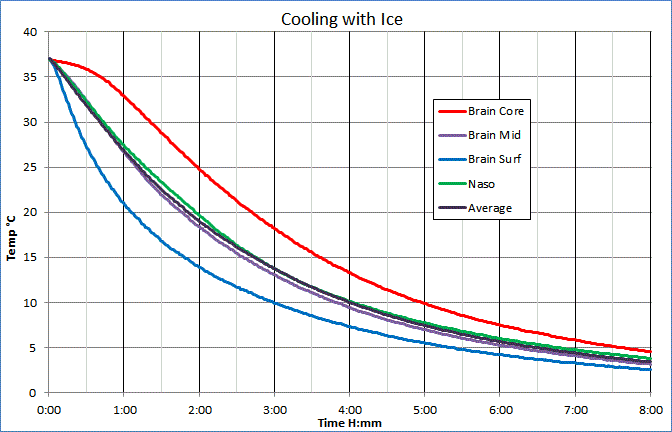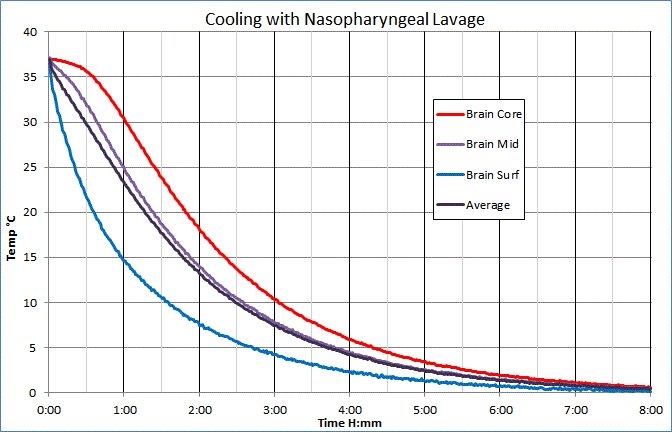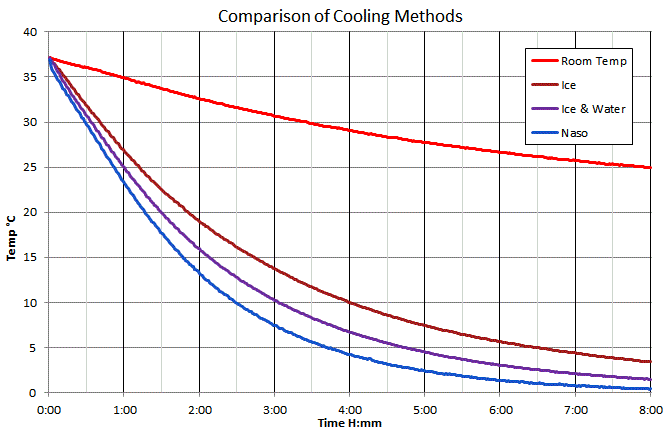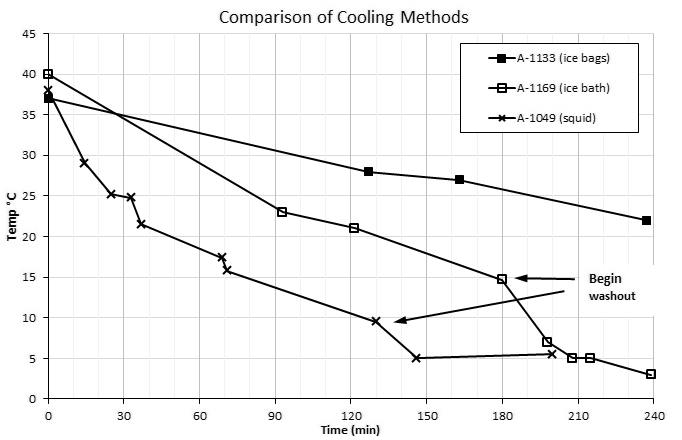back to R&D
With every cryonics case, our first tool for slowing degradation is to induce hypothermia with external cooling. We have performed some basic testing on cooling rates for different kinds of external cooling.
Methods
A series of human cadavers were used. A temperature probe array was placed through a burr hole in the midline of the vertex of the calvarium. The probe was designed to stop firmly against the exterior of the skull bone. From that point, it extended down 8 cm to a thermocouple (TC) at the tip. This TC was labeled "Brain Core". A second TC was placed 3 cm from the tip, or 5 cm from the exterior bone surface, and labeled "Brain Mid". A third TC was placed manually by diagonally inserting it between the brain and the dura mater. This TC was labeled "Brain Surf". Opening was sealed with wax or epoxy, and scalp was approximated and stapled. A final TC was placed through the right nares and advanced into the nasopharynx. CT scan was performed to verify placement of all probes and to record for future analysis complex parameters such as volume and density. Cephalon was enclosed in a plastic bag and warmed in a water bath until stable at 37°C. Initiated one of a number of cooling protocols, using software to record cooling curves.
Results
These results are fairly complete, but will be refined and further explained over time. For example, no adjustments are currently made for different skull thicknesses or head sizes.
Cooling with Ice
5 sample cases
Ice cubes were placed around the cephalon, and melted water was allowed to constantly drain off. The ice cubes were unbagged, and were at 0°C rather than the colder -20°C that ice cubes might be straight from a freezer.

Cooling with Ice and Water
13 sample cases
Cephalon was placed in ice and water. After about 20 minutes, ice cubes were added and water drained off as needed. The water was not stirred.

Cooling with Nasopharyngeal Lavage
6 sample cases
Tubing was clamped to both nares. Ice water was constantly pumped in, which also caused agitation in the ice water surrounding the cephalon.

Cooling at Room Temperature
6 sample cases
Room temperature was 20°C, and the air was fairly still. Cephalon was not in significant contact with any hard surface.

Comparison of Cooling Methods
This chart summarizes the Averages from each of the above charts.

Discussion
The nasopharyngeal probe data is noticeably different between the ice and the icewater protocols. This is because, in the case of the icewater, the pressure of the water caused the plastic bag to press closely against the skin of the face. When only ice was used, it left an air gap around the face under the plastic bag. When there is no air gap, the bones of the face cool faster, at the same rate as the surface of the brain where the probe was placed. This observation simply reinforces the obvious fact that external cooling is most effective when approached from all sides of the sphere.
The cooling curves above are showing different data than has been presented anywhere else. Specifically:
-No CPR is being performed. The blood is static, so no heat is being transferred from the body core up to the brain.
-No washout is being performed. This data is relevent only up to the point where washout begins, which is ideally within just a few minutes.
-This is head only. We are not interested in the rest of the body.
This comparison is from http://www.alcor.org/Library/html/fried.html. While this data is interesting, for the reasons listed above, it's not very closely related to our data. These are more complex and variable scenarios than our static cooling.

